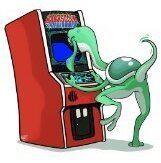
This ended up being one of the quickest repairs I have done. It probably took longer to hook up the board. The problem chip ended up being the second chip I did a spot check on: the 74ls00 at 3D. Probing the chip, I noticed that it had good inputs.
However, it had floating outputs:
Stacking a new chip on it fixed my graphics. That was ultimately the problematic chip. Pulling it and testing it on my chipmaster shower it to be bad.
Fully replacing the chip solved my graphics issue.
- Read more...
- 0 comments
- 76 views

